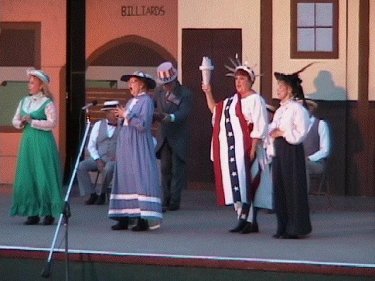
A scene from the Music Man
The Roswell Community Little Theater is presenting its finale of the 2001-2002 season with two different types of productions, casts and stages.
The Music Man is held at the Roswell Amphitheater, off East College near the Roswell Wool Bowl Complex, on Friday, Saturday and Sunday nights of the following weekends: July 19-21, July 26-28, August 9-11 and August 16-18. Each show begins at 7:30 p.m.
Small Talk, a youth production, is held in the RCLT theater at 1101 N. Virginia on the weekend of August 2,3,4 (beginning 7:30 p.m. Friday and Saturday, and 2 p.m. on Sunday).
The next season (2002-2003) opens October 11 with a three-act thriller, Something to Hide. A total of five regular season plays are scheduled for this season, plus a Halloween-time fund-raiser for the Roswell Public Library, a spring-time fundraiser for the Roswell Museum and RCLT, and a summer youth production.
The RCLT is working towards the design and construction of a new community-oriented facility that will house a modern theater and enhance the area on North Virginia Avenue.
The New Building Design Committee, chaired by Terry Barnes Rhodes, has completed preliminary drawings and a working model of the projected facility. He has begun to interview local architects.
Their plans for this project include a stage with an orchestra pit, an auditorium to seat 200 people, a lobby to accommodate 150 people at a sit-down dinner, a kitchen that can handle catered events, a black box rehearsal hall, office space, meeting rooms, a shop to hold scene props and costume storage, and an outdoor theater to face the Spring River Corridor. The estimated amount needed for construction is $1 to $2 million. Once the RCLT Executive Board selects the architect and the design is finalized, RCLT will launch a major fund-raising campaign to raise the money required for the project.
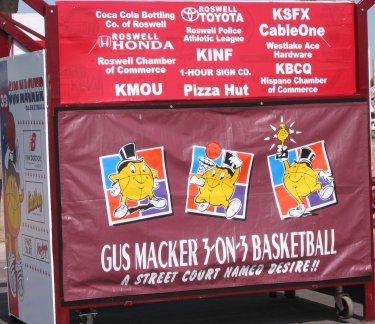
Gus Macker has come and gone from Roswell’s Wool Bowl Complex, but it will come again as it has for 16 consecutive summers.
Since 1987, it has traveled across the U.S.A., taking its goals and hoops to the willing masses waiting to dunk free.
According to Jim Schultz, the local Gus Macker director, this year’s tournament had 32 playing courts, 415 teams and 1,660 players. Schultz also said that, during its peak time Saturday, there were an estimated 11,000 to 12,000 spectators. The spectator number-crunching was provided by the Roswell Police Department. Since the tournament spanned two full days, double those numbers for an estimation of spectators drawn to the tournament — as many as 22,000. Based on those numbers and using the Roswell Chamber of Commerce’s formula for estimation, it could be fair to say that Gus Macker generated $2 million within the community.
Those numbers alone make it clear that Gus Macker is a big deal to Roswell and the surrounding area. Besides giving all interested local athletes and wanna-be athletes an opportunity to play, it brings in players and spectators from other communities. Roswell receives many benefits from Gus Macker.
Gus Macker, 28 years old, was not born in Roswell but you could say it made its debut here years later as a traveling hoopster phenomenon.
It is a three-on-three outdoor basketball tournament — the size of and generating the exciting atmosphere of a large multiple-ring circus. It has many small rings (i.e. miniature courts) of electrifying activity, each with its own individual cheering audience, that go on simultaneously.
Gus entices kids of all ages.
It began when brothers Scott and Mitch McNeal gathered student friends to play in their parents’ driveway in 1974 during spring break in Lowell, Michigan. The game continued to be played, confined to the original area, for more than a decade. In 1986, Cla Avery took some of his middle-school students to Lowell to play Gus Macker, and the idea of taking the tournament on the road was born.
The following year, the tournament began touring the USA. Roswell, New Mexico was one of the first stops on that first traveling agenda in 1987. Ever since, it has effected many locales and players. Currently the numbers are 150,000 players in 60 cities across the country.
A Gus Macker tournament is made up of many teams of four, three on court and one substitute player. Each team challenges another team in the same age and gender category in its own pint-sized arena/court. Teams vary from 10 years old and younger, up to 30 years old and older.
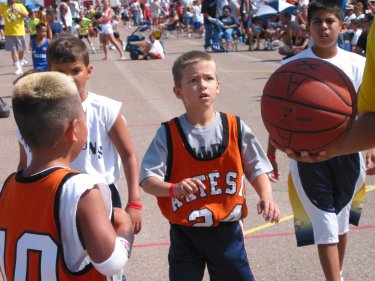
Here is an apt illustration of how far Cla has gone for his kids: In 1986, he took middle-school students from Roswell, New Mexico to play Gus Macker in Lowell, Michigan.
But it was no coincidence that Cla took Roswell students to Lowell.
It happened that when Cla was coaching in Roswell, his parents lived in Lowell. Keith and Carol Avery, parents of Cla, taught there, and Keith had been Mitch McNeal’s 9th grade science teacher.
As Gus Macker’s P.A. supervisor, Cla continues to be a Gus Macker national staffer, which takes him across New Mexico and other regions, including Florida for the annual national tournament, but he is no longer involved with the local Gus Macker tournaments except as P.A. announcer. He has remained actively involved on the local level, however, with Grid Iron. Grid Iron is related to and similar to the Gus Macker tournaments, except it is football instead of basketball.
Jim Schultz has been the director of the local Gus Macker tournament for the past three years.
In the 1970s, the Avery family lived in Springer, in northeastern New Mexico. There, Carol taught high school English; Keith, a professional western artist, continued to paint and successfully promote his artwork across the U.S.A. and wrote cowboy poetry; Cla attended college at Highlands University in nearby Las Vegas, from where he acquired his teaching degree.
In case you’re wondering, it isn’t that we don’t know how to spell Clay. Carlton L. Avery has been called Cla, his initials made into a nickname, his entire life.
After Cla retired from teaching and coaching at Roswell’s Mountain View Middle School for 25 years, he continued to work with and positively promote youth. He is executive director of Character Counts! of Chaves County. That is an ongoing endeavor — of challenging students to have and reflect good ethics and characteristics in various ways — culminating with a large youth recognition banquet in the spring of each year.
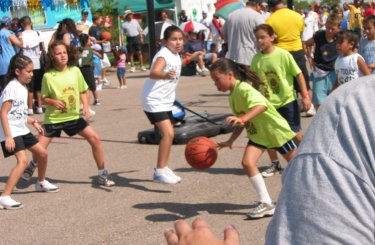
Besides his leadership of large undertakings — like Character Counts! and Gus Macker and Grid Iron — that benefit the entire community as well as its youth, Cla continues other involvements with students and their sports.
Cla Avery is also a fine professional artist.
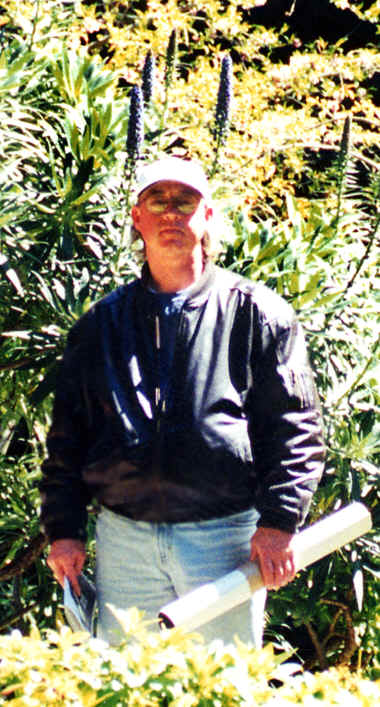
The subject line of love aroused my curiosity.
I should have left that mouse alone, I’m sorry I did click.
The one who sent their love to me, played me a dirty trick.
Hidden in the words of love that danced upon my screen
A malicious love virus danced in there unseen.
It danced into my documents and sent them far and wide.
Some to folks unknown to me, who angrily replied.
It danced into my address book and randomly chose names,
To receive the words of love that make computers lame.
I quickly sent a message out to all names on my list,
“Please don’t open mail from me, loves virus does exist.”
Then I clicked on disconnect to stop the virus dance,
But now the bug was in control, the PC had no chance.
I shut it down and pulled the plug and took it to the shop,
Hoping they would find the way to make the dancer stop.
I called them in the morning and I called again at noon
Hoping that my sick computer sure would be well soon.
“Your computer’s better now, of that I have no doubt.
It really was a tricky job to chase that virus out.”
Other words of wisdom the repairman said to me,
“Be sure your Norton’s up to date, so you’ll be trouble free.”
After my experience, these words I know are true,
Having a computer virus isn’t like the “flu.”
Who knows what evil lurks out there, just waiting for the chance
Of sneaking in with your e-mail to do a virus dance.
* The average life expectancy in the U.S. was 47.
* Only 14% of the homes in the U.S. had a bathtub.
* Only 8% of the homes had a telephone. A three-minute call from Denver to New York City cost $11.
* There were 8,000 cars in the U.S. and 144 miles of paved roads.
* The maximum speed limit in most cities was 10 mph.
* Alabama, Mississippi, Iowa and Tennessee were each more heavily populated than California. With a mere 1.4 million residents, California was only the 21st most populous state in the Union.
* The tallest structure in the world was the Eiffel Tower.
* The average U.S. wage was 22 cents an hour.
* The average U.S. worker earned between $200 and $400 a year.
* A competent accountant could expect to earn $2,000 per year, a dentist $2,500 a year, a veterinarian between $1,500 and $4,000 a year and a mechanical engineer about $5,000 a year.
* More than 95% of all U.S. physicians had no college education. Instead, they attended medical schools, many of which were condemned in the press and by the government as substandard.
* Sugar cost 4 cents a pound; eggs were 14 cents a dozen.
* Coffee cost fifteen cents a pound.
* Most women only washed their hair once a month and used borax or egg yolks for shampoo.
* Canada passed a law prohibiting poor people from entering the country for any reason.
* The five leading causes of death in the U.S. were: a.) pneumonia and influenza, b.) tuberculosis, c.) diarrhea, d.) heart disease, and e.) stroke.
* The American flag had 45 stars. Although they were U.S. territories, Arizona, Oklahoma, New Mexico, Hawaii and Alaska were not among the United States of America.
* The population of Las Vegas, Nevada was 30.
* Crossword puzzles, canned beer and iced tea had not been invented.
* There were no Mother’s Day or Father’s Day.
* One in ten U.S. adults could not read or write. Only 6% of all Americans graduated from high school.
* Marijuana, heroin and morphine were available over the counter at corner drugstores. According to one pharmacist, heroin clears the complexion, gives buoyancy to the mind, regulates the stomach and bowels and is, in fact, a perfect guardian of health.
* In the U.S., 18% of households had at least one full-time domestic or servant.
* About 230 murders were reported in the entire U.S.A.
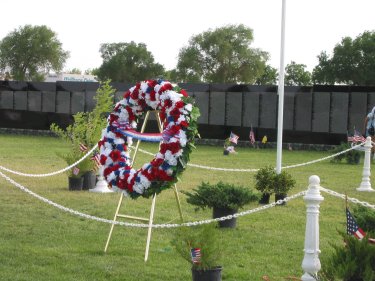
The Vietnam Veterans Memorial Moving Wall — dedicated “To Honor, To Heal and To Remember”– was in Roswell June 10 through June 17. Area residents continue to speak of the healing that came with that personalized memorial of lives lost in a war that still haunts many.
For an in-depth article on the Moving Wall in Roswell and additional photos, go to the Archives, then the Focus page of the previous issue.
AMERICA’S DAY OF INDEPENDENCE, CELEBRATED ON THE 4TH OF JULY
Thanks to the generosity of many, Roswellites and their guests were awed by a celebration that lit the night with light. Two, in fact.
2002 Fourth of July Salute to Veterans and Fireworks Extravaganza at Cielo Grande Recreation Area began with patriotic music provided by the Chaves County Community Youth Band Camp and a parade of veterans honoring area veterans of all wars, before the Fireworks Extravaganza began. (As explanation for those who have long gone from the area, Cielo Grande is at the site of the old municipal airport.)
The other celebration, held at the Eastern New Mexico State Fairgrounds, lit the Fourth of July night skies south of Roswell. It — like a previous community fireworks display — was provided by the generosity of Ritter & Company LLC.
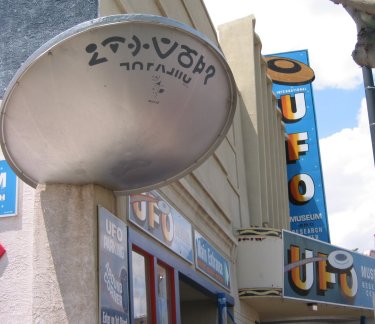
They came and they saw. Nearly 10,000 aliens and ordinary folks visited Roswell during the 3 1/2 days of the UFO festival. That number, however, only counts those who took time to sign their names at the UFO Museum and Research Center (pictured above). With so much else to see and do, many visitors never got to the UFO museum, and of those who did, a large percent did not stand in the long line to sign the register.
The Roswell 2002 UFO Festival — “after 55 years, the mystery continues” — ran from Thursday, July 4, through Sunday, July 7 with many events taking place all over the city. According to a spokesman for the Roswell Chamber of Commerce, $5.1 million was generated last year by the UFO tourist industry in Roswell.
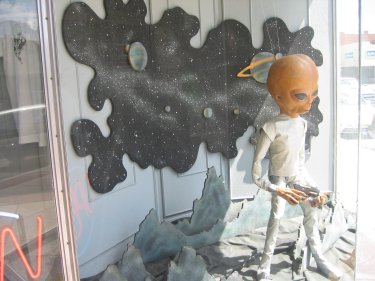
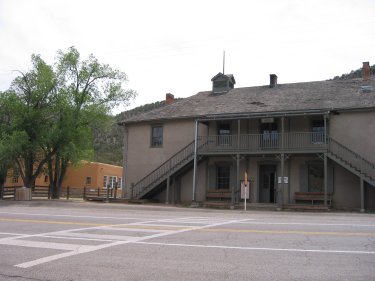
Billy the Kid Outlaw Gang (BTKOG) had their annual campout July 11 through July 14 at Campsite #2, in the Cedar Creek Campground, also known as Sam Tobias Memorial Group Area. For a while, with the Lincoln National Forest closed to campers due to the fear of fires, it was uncertain whether BTKOG could hold their annual campout there. But thanks to rains that began coming to this and surrounding areas just before the 4th of July, the campout was held as scheduled.
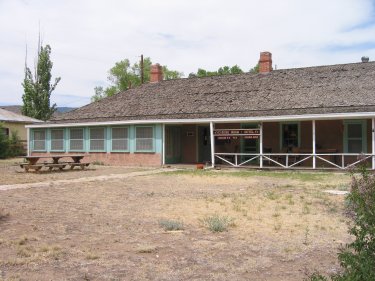
Billy the Kid Outlaw Gang Gangster!
 Roswell Web Magazine
Roswell Web Magazine